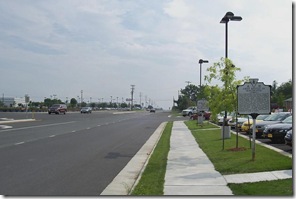 Marker No. A-11
Marker No. A-11
Frederick County, VA
Marker Text: Here Confederate Maj. Gen. Thomas J. “Stonewall” Jackson and his army, early on the morning of 25 May 1862, defeated Union Maj. Gen. Nathaniel P. Banks' forces during Jackson's Shenandoah Valley campaign. Banks, outnumbered and outflanked, hastily retreated north through the streets of Winchester. The Confederate pursuit was lethargic, as the men were exhausted from a week of heavy marching, but they captured many Union soldiers and a large quantity of wagons and stores. Because of Jackson's victory here, the Valley was temporarily cleared of Federal armies. President Abraham Lincoln diverted 30,000 men from the Union advance on Richmond to strike at Jackson.
Location: On U.S. Route 11 (Valley Pike), 0.1 miles south of Route 37, south of Winchester. Marker grouped with Marker A-8 (Second Battle of Winchester). Erected by the Department of Historic Resources in 2006.
This is a newer marker with an expanded text. Older Marker Text read: “The main body of Stonewall Jackson's army halted here to rest in the early morning of May 25, 1862.”
Today, 150 years ago, on the early morning of May 25, Confederate Maj. Gen. Thomas J. “Stonewall” Jackson rested the main body of his army here before proceeding into Winchester, VA to attack Union Maj. Gen. Nathaniel P. Banks' army. Jackson's army had just marched from Front Royal, VA during May 24.
After skirmishing with Maj. Gen. Nathaniel P. Banks’s retreating army at Middletown and Newtown (now, Stephens City) on May 24, Maj. Gen. Thomas J. "Stonewall" Jackson’s division continued north on the Valley Pike (U.S. Route 11) toward Winchester. About two miles further north, Banks was attempting to reorganize his army to defend the town. Stephens City is only about two miles south of this marker.
Photo taken looking south on Route 11 toward Stephens City. Click any photo to enlarge.
As Jackson's army rested here an advance group was observing the Union army establishing defensive positions at Bower's Hill before the beginning of the battle. The First Battle of Winchester was a major victory in General Jackson's 1862 Valley Campaign. On the tactical level, the battle displays considerable finesse, particularly on the part of Ewell's division employed further east on the Front Royal Pike.
With the collapse of both Union flanks, Union forces retreated through the streets of Winchester and north on the Valley Pike. Confederate pursuit was lethargic, as the troops were exhausted from the non-stop marching of the previous week. Nevertheless, many Union prisoners fell into Confederate hands. Nevertheless, many Union prisoners fell into Confederate hands. Brig. Gen. Turner Ashby's cavalry was disorganized from the actions of May 24 and did not begin their pursue until Banks had already reached the Potomac River.
The ultimate significance of Jackson's victory at Winchester was its strategic impact. Union plans for a convergence on Richmond were disrupted by Jackson's audacity in the Shenandoah Valley and thousands of Union reinforcements were diverted to the Valley and the defense of Washington, thereby preventing other Union troops from being sent to Richmond to assist Union General McClellan's Army in the Peninsular Campaign.

No comments:
Post a Comment